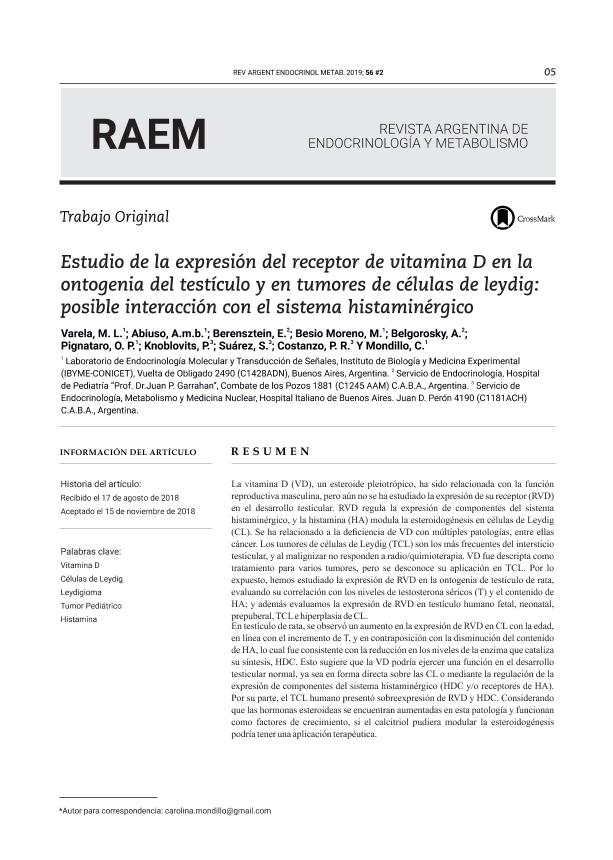Artículo
La vitamina D (VD), un esteroide pleiotrópico, ha sido relacionada con la función reproductiva masculina, pero aún no se ha estudiado la expresión de su receptor (RVD) en el desarrollo testicular. RVD regula la expresión de componentes del sistema histaminérgico, y la histamina (HA) modula la esteroidogénesis en células de Leydig (CL). Se ha relacionado a la deficiencia de VD con múltiples patologías, entre ellas cáncer. Los tumores de células de Leydig (TCL) son los más frecuentes del intersticio testicular, y al malignizar no responden a radio/quimioterapia. VD fue descripta como tratamiento para varios tumores, pero se desconoce su aplicación en TCL. Por lo expuesto, hemos estudiado la expresión de RVD en la ontogenia de testículo de rata, evaluando su correlación con los niveles de testosterona séricos (T) y el contenido de HA; y además evaluamos la expresión de RVD en testículo humano fetal, neonatal, prepuberal, TCL e hiperplasia de CL.En testículo de rata, se observó un aumento en la expresión de RVD en CL con la edad, en línea con el incremento de T, y en contraposición con la disminución del contenido de HA, lo cual fue consistente con la reducción en los niveles de la enzima que cataliza su síntesis, HDC. Esto sugiere que la VD podría ejercer una función en el desarrollo testicular normal, ya sea en forma directa sobre las CL o mediante la regulación de la expresión de componentes del sistema histaminérgico (HDC y/o receptores de HA).Por su parte, el TCL humano presentó sobreexpresión de RVD y HDC. Considerandoque las hormonas esteroideas se encuentran aumentadas en esta patología y funcionan como factores de crecimiento, si el calcitriol pudiera modular la esteroidogénesis podría tener una aplicación terapéutica. Vitamin D (VD) is a steroid hormone traditionally related to bone health. However, several authors have associated VD with reproduction and steroidogenesis in males. The presence of VD receptor (VDR) and the enzymes involved in its activation had been reported in several cell types of the testes. Until now, nobody has studied RVD expression during testicular development. In addition, VDR in association with its coactivators or co-repressors, regulates the expression of several genes, including those related to the histaminergic system. Previously, we demonstrated that histamine (HA) can modulate steroidogenesis in Leydig cells (LC) in a concentration-dependent manner. Also, we observed a decrease in the endogenous HA content, consistent with the previously described decrease of HDC (histidine decarboxylase, the enzyme responsible of HA synthesis) levels, during LC ontogeny. Epidemiologic studies strongly suggest that a relationship exists between VD deficiency and multiple pathologies, particularly cancer. Leydig cell tumors (LCT) are rare endocrine tumors ofunknown etiology, which originate in the testicular interstitium. The incidence worldwide is 1-3% in adults and 4% in prepubertal boys, but recent publications indicate that these figures have been increasing. While usually benign, approximately 10% of LCTin adults become malignant and do not respond to chemo or radiotherapy. It is imperative to deeply investigate the biology of LCT, to identify new therapeutic targets. The potential role of calcitriol (1α,25(OH)2-vitamin-D3) in cancer treatment has been described for several types of tumors, but it remains unexplored in LCT. Thus, as a first step, it is worth evaluating VDR expression in LCT.In view of the aforecited evidence, herein we studied VDR expression during the rat testicular ontogeny, evaluating a possible correlation withserum testosterone (T) levels in blood, endogenous levels of HAand the previously described HDC expression levels. We also analized VDR expression in human testes corresponding to three different stages of development (fetal, neonatal and juvenile), in LCTand in LC hyperplasia. Methods: Rat testes of different ages (7, 21, 35, 90 y 240 days), human fetal, neonatal and pre pubertal testes, a human LCT and a human LC hyperplasia; were used for detection of VDR by immunohistochemistry.
Estudio de la expresión del receptor de vitamina D en la ontogenia del testículo y en tumores de células de Leydig: posible interacción con el sistema histaminérgico
Varela, María Luisa ; Abiuso, Adriana María Belén
; Abiuso, Adriana María Belén ; Berensztein, Esperanza Beatriz; Besio Moreno, Marcos Alberto
; Berensztein, Esperanza Beatriz; Besio Moreno, Marcos Alberto ; Belgorosky, Alicia
; Belgorosky, Alicia ; Pignataro, Omar Pedro
; Pignataro, Omar Pedro ; Knoblovits, Pablo; Suárez, Sebastián; Costanzo, P. R.; Mondillo, Carolina
; Knoblovits, Pablo; Suárez, Sebastián; Costanzo, P. R.; Mondillo, Carolina
 ; Abiuso, Adriana María Belén
; Abiuso, Adriana María Belén ; Berensztein, Esperanza Beatriz; Besio Moreno, Marcos Alberto
; Berensztein, Esperanza Beatriz; Besio Moreno, Marcos Alberto ; Belgorosky, Alicia
; Belgorosky, Alicia ; Pignataro, Omar Pedro
; Pignataro, Omar Pedro ; Knoblovits, Pablo; Suárez, Sebastián; Costanzo, P. R.; Mondillo, Carolina
; Knoblovits, Pablo; Suárez, Sebastián; Costanzo, P. R.; Mondillo, Carolina
Fecha de publicación:
10/2019
Editorial:
Sociedad Argentina de Endocrinología y Metabolismo
Revista:
Revista Argentina de Endocrinologia y Metabolismo
ISSN:
0080-2077
Idioma:
Español
Tipo de recurso:
Artículo publicado
Clasificación temática:
Resumen
Archivos asociados
Licencia
Identificadores
Colecciones
Articulos(IBYME)
Articulos de INST.DE BIOLOGIA Y MEDICINA EXPERIMENTAL (I)
Articulos de INST.DE BIOLOGIA Y MEDICINA EXPERIMENTAL (I)
Citación
Varela, María Luisa; Abiuso, Adriana María Belén; Berensztein, Esperanza Beatriz; Besio Moreno, Marcos Alberto; Belgorosky, Alicia; et al.; Estudio de la expresión del receptor de vitamina D en la ontogenia del testículo y en tumores de células de Leydig: posible interacción con el sistema histaminérgico; Sociedad Argentina de Endocrinología y Metabolismo; Revista Argentina de Endocrinologia y Metabolismo; 56; 2; 10-2019; 5-13
Compartir



